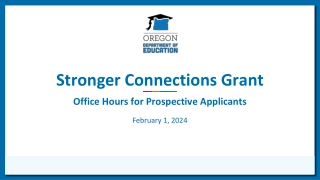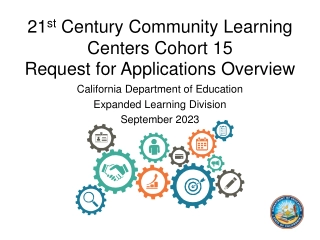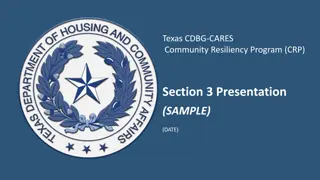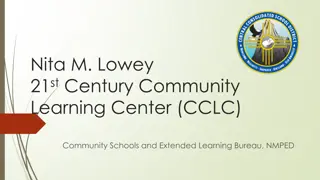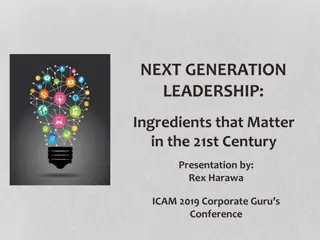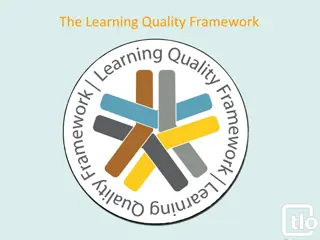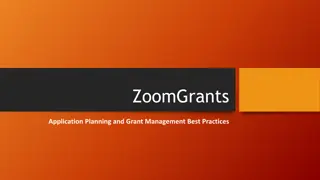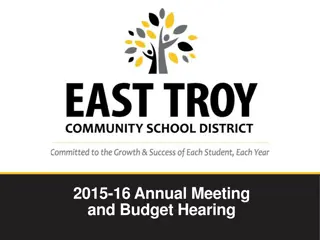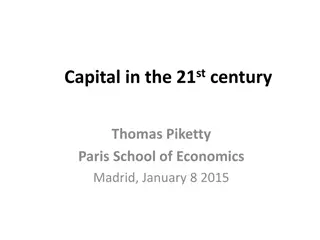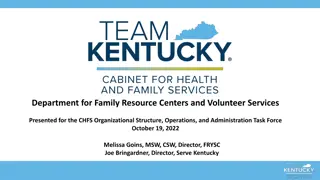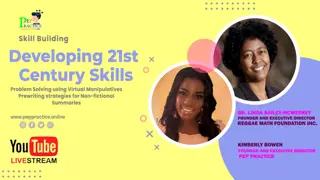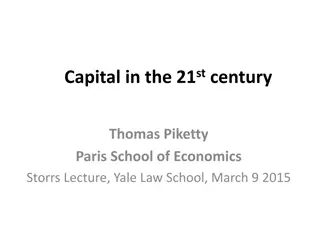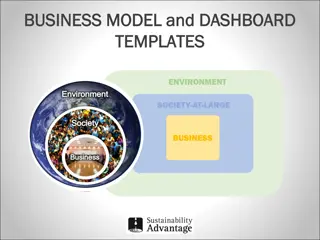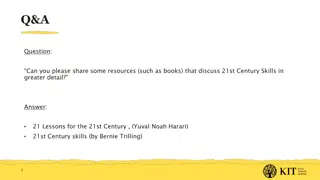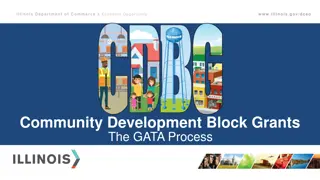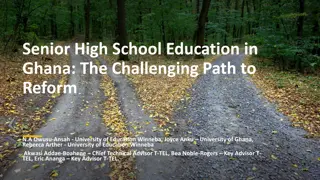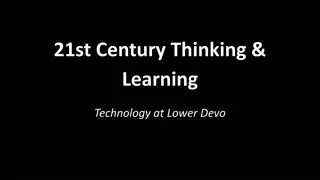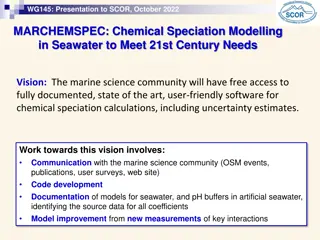Enhancing Learning Opportunities through 21st Century Community Learning Centers (CCLC) Grant
The 21st Century Community Learning Centers (CCLC) grant program, part of the Every Student Succeeds Act, supports additional learning time for students through enriching programs. These programs aim to increase engagement, provide a well-rounded education, and empower diverse student populations. Grant priorities include project-based learning, student support systems, and data-driven program enhancements. Students from marginalized backgrounds are prioritized, emphasizing inclusivity and equity in education.
- Community Learning Centers
- Student Engagement
- Education Equity
- Project-Based Learning
- Student Support
Download Presentation

Please find below an Image/Link to download the presentation.
The content on the website is provided AS IS for your information and personal use only. It may not be sold, licensed, or shared on other websites without obtaining consent from the author. Download presentation by click this link. If you encounter any issues during the download, it is possible that the publisher has removed the file from their server.
E N D
Presentation Transcript
Introduction to 21stCentury Community Learning Centers (CCLC) Supporting Additional Learning Time Grant (SALT) 1
Nita M. Lowey 21stCentury Community Learning Centers Program The 21stCentury Community Learning Centers (21stCCLC) initiative is a key component of the Every Student Succeeds Act (ESSA). Authorized under Title IV, Part B of the Elementary and Secondary Education Act (ESEA), as amended by the Every Student Succeeds Act (ESSA) of 2015. 2 2
MA 21CCLC MA 21st CCLC support additional learning time through the implementation of academically enriching programming that increases student engagement and contributes to a well-rounded education. MA 21st CCLC programs strive to ensure that learning is meaningful, collaborative, supports mastery, and expands horizons. Programming occurs during Out-of-School Time (OST) and/or as part of Expanded Learning Time (ELT a longer school day/year for all students). 3 3
Overarching grant priorities include using more time to: Contribute to students well-rounded education by implementing high quality project-based learning that is multi-disciplinary and supports standards-aligned learning in core subject areas. Strengthen student learning during the school year and summer by combining content knowledge with interactive, relevant, and engaginglearning experiences that emphasize the skills necessary to apply that knowledge successfully Develop systems of support that are culturally relevant - and leverage the knowledge, strengths, and assets of students, families, educators, and the community. Use data effectively in designing programming that addresses student needs and interests and in demonstrating continuous program improvement efforts. 4 4
Students Served 21CCC program engage students and families with identities and cultures that have been historically marginalized in educational settings - including but not limited to students from families who are low income; students who are Black, Indigenous, and People of Color (BIPOC); first generation students; emerging multilingual students; students with Individualized Education Programs (IEPs); and lesbian, gay, bisexual, transgender, queer and questioning (LGBTQ+) students. Note: Although students are designated in statute as the intended beneficiaries of the program, younger children who will become students in the schools being served may also participate in program activities designed to get them ready to succeed in school. Childcare is not allowable for 21st CCLC 5 5
Grounding Ourselves in DESE DEI Values Joy: We elevate stories of strength and beauty and take an assets-based approach to counter the deficit-based approach that has historically been used to marginalize BIPOC and other communities Courage: We are willing to be bold in our decisions and actions because the status quo is not acceptable, as it predicts outcomes based on race and other identifiers. Learning: We are a learning organizationand as such are willing to fail, acknowledge shortcomings, and use new learnings for continuous improvement. Partnership: We work in partnership with districts, programs, families, and community partners and work to model, share, and replicate practices that advance equity. Accountability: We continuously monitor the impact of our actions and inactions and are intentionally and collaboratively responsive to the needs and concerns of those most impacted by the issues we are committing to improve Care: We invest in our individual and collective health and well-being in order to promote healing and sustain hope. 6 6
The 21CCLC Program aligns with and enhances the Commissioner s Priorities Deeper Learning - students work on meaningful projects with larger purpose Holistic Support & Enrichment- ensure all students receive strong foundational supports and enriching experiences beyond core academics. Innovation and Evidence-Based Practices, and the State as a Partner 7 7 7
MA 21st CCLC Grant MA 21st CCLC Grant MA 21st CCLC Grant supports schools and organizations in partnership with schools in taking a multifaceted approach to creating opportunities to think creatively and critically about how we equitably prepare students for success and Support interactive, relevant, and engaging teaching and learning opportunities. Supports programing that is purposeful and intentional in design and implementation. 8 8
Applicants must meet at least one (1) of the following: Serve students in schools designated as Title I School-Wide programs Serve students in schools with 15% students who are Economically Disadvantaged (ED) Non-school/city/town applicants must demonstrate: they will implement in partnership with a school/district that meets the eligibility requirements capacity to manage and administer the program (annual audit) Basic Eligibility 9 9
Non-Public School Entities Must have a Unique Entity ID (EI #) - the official identifier for doing business with the U.S. Government as of April 4, 2022. On April 4, 2022, the federal government stopped using the DUNS Number to uniquely identify entities. Now, entities doing business with the federal government use the Unique Entity ID created in SAM.gov. Must have an annual audit to demonstrate infrastructure to meet all federal and state reporting requirements Must have a demonstrated and collaborative partnership with a school that meets the eligibility requirements. 10 10 10
(OST) ELT Out-of-School Time Expanded Learning Time ADDING at least 180 hours to the school day/year, required for all students AND OFFERING at least 120 hours (or the difference between 300 hours and the amount of time added to the required school day/year) to a selected group of students Offer at least 400 hours of comprehensive OST (SY & Summer) programming (not drop-in) for a selected group of students. Please note the majority of hours MUST occur during the school year. Existing OST programs (without current 21st CCLC funding) may apply but must demonstrate expanded or enhanced services/programming. Allowable Models for Adding Time 11 11
OST Students are required to attend on a regular and consistent basis. There are attendance requirements based on level (EL, MS, HS) outlined in the application. Drop-In or drop in like programs are NOT ALLOWED. Students MUST attend for the entire programming day OST & ELT- Robust Reporting and Federal and State Evaluation Requirements- Report on ALL students served by the grant Students may not be charged to attend a 21CCLC SY or summer program. Eligibility Continued 12 12
What you can be working on now 13 13 13
21st CCLC Grant Guiding Question 21st CCLC Grant Guiding Question How can students see what they are learning as connected and meaningful to their lives? 14 14
Process A critical first step in the innovation process involves making sure you re solving the right problem or addressing the right question. 15 15 15
Applicants are required to conduct an assessment to identify the needs of the students, families, and community and school(s) to be served. Collect and analyze quantitative, qualitative and anecdotal data that is pertinent to the specific students and families the program will serve. Identify the existing school/community resources and where the gaps may exist. Assess interest of students, families, teachers in having a 21st CCL program. There needs to be authentic buy in. Identify how the 21CCL Grant will build upon/leverage existing resources or address the gaps. Should also include an assessment of the social emotional, physical, and cognitive needs of the students identified to be served. Conduct a Needs Analysis 16 16
Organize a planning team Identify one person to lead collaboration a team of people to develop plan that is aligned to school and community improvement goals and student interests. A team to review plan and contribute feedback Review FY23 SALT Grant Application Develop a needs assessment plan/process Review Data CBO s Formulate or strengthen school partnerships and identify key school leaders and personnel Planning Teams should include School principal, asst. principle, teachers, curriculum coordinator, special education, grade level team leads, teachers of ELS, family members, current or potential new partners . Collaboration 17 17
Examples of data and resources that help drive planning process School Improvement Plans School Benchmark Data (EDWIN) School Climate Data Chronic absenteeism data Suspension data Interest Surveys (Student, Family, Teacher/Staff) Views of Climate and Learning (VOCAL) Survey Project - VOCAL is an annual survey sponsored by DESE. Participating students are asked to share their views on three dimensions and nine topics of school climate. Youth Risk Behavior Survey 18 18 18
Your needs assessment should clearly identify, articulate and prioritize, the specific challenges and barriers to learning that your program will address. Using what you have determined and heard through data analysis, interest surveys, school and district improvement and other strategic plans: Identify the primary need or gap that your program will address. Design process begins. 19 19 19
When we collaborate to align programming to school day learning, we increase the value of the 21st CCLC program to the school, the community, families, and ultimately the students who are served by the program. 20 20 20
What alignment is: What alignment is: Ensuring that . Students engage and explore academic concepts in unique ways Academic needs of participating students are met through creative and high interest programs Program activities complement the academic content of the school day Purposeful programming that supports intended outcomes and contributes to developing mastery 21 21 21
What alignment is What alignment is NOT NOT? ? Monotonous, unimaginative, rote learning E.g., reading informational text, discussing the text, and answering questions at the end of the passage, work sheets Attempting to link pre-determined activities with grade level standards E.g., baking cupcakes and trying to find a grade-level standard to align with it Purchasing a preset academic curriculum and completing the activities in order The activities may not be what the students need or want or contribute to developing mastery, identity and creativity 22 22
Consultation with Non Consultation with Non- -Public Schools Public Schools Required for ALL applicants Must consult with private school officials in their catchment area during the design and development of the 21st CCLC program. Consultation must be timely and meaningful. The lead applicant remains in control of funds Services must be secular, neutral and non-ideological. Recommend consulting with your Title I program on their process. 23 23 23
Application released late March / Early April Webinars to review /Q & A Sessions dates posted on our web site doe.mass.edu/21cclc/ and noted in in RFP Department Notification of Intent to Apply Submission of the Intent to Apply does not obligate the applicant to submit a proposal. Application will be due approximately Mid May for a 9/1/23 start date Posted on Grants Web page https://www.doe.mass.edu/grants/current.html RFP Timeline 24 24



